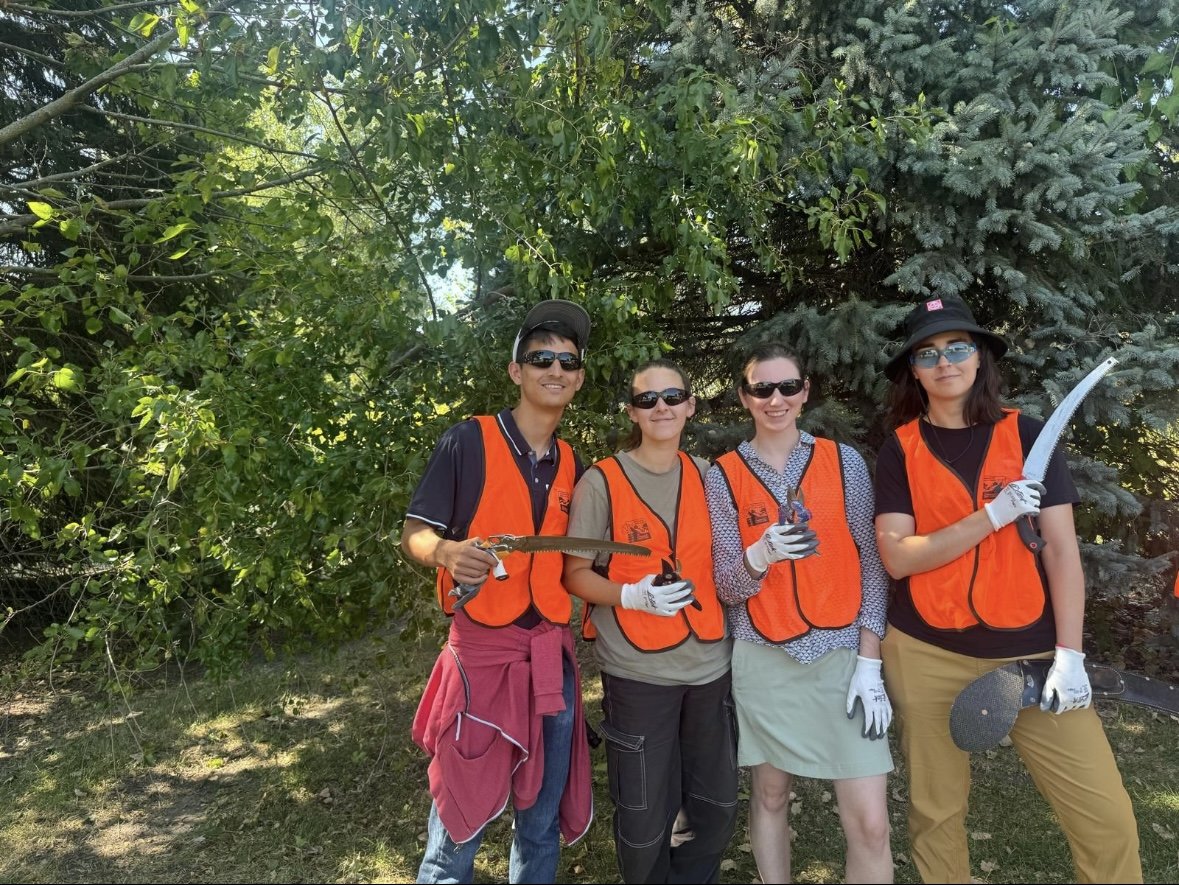Discover the Importance of Tree Maintenance
With support from enFocus, the City of South Bend received $1.87 million through the USDA Forest Service’s Urban and Community Forestry grant in September 2023. In managing this award, enFocus continues to partner with the City to help reach its goals to expand the Urban Tree Nursery Network, establish permanent plantings at schools, and bolster education and workforce development. To meet the goal of planting around 9,000 trees over five years as covered by this grant, our team is committed to learning firsthand the processes of planting and maintaining trees.
Trees are a crucial component of a thriving urban landscape–and are vital to mitigate the effects of climate change, retain stormwater, improve well-being, and provide aesthetic beauty. However, without proper management, planning, and maintenance, they can become hazardous or even unwanted.
enFocus Fellows Anna McVay and Jon Huber, along with Office of Sustainability Project Manager Barbara Dale, had the opportunity to represent the City of South Bend at the Tree Stewards program in Portage, Indiana. This two-day training was hosted by the Indiana Department of Natural Resources’ Community and Urban Forestry Program, and involved tree advocates across the region.
(From left to right): Jon Huber, Katie Lane (Unity Gardens), Anna McVay, and Barbara Dale are ready to prune some overgrown trees behind them
The schedule was full of exciting presentations given by a range of forestry professionals. A soil ecologist explained the different soil classifications, and the importance of sampling soil for the proper pH, micronutrients, and macronutrients in growing healthy and long-living trees. Certified arborists presented strategies for identifying tree species, and common tree problems to be aware of in an urban landscape. An entomologist shared tree pests of greatest concern (such as the Spotted Lanternfly), signs of their presence, and what to do if you encounter one.
Steve Lane from Great Lakes Urban Forestry led an in-depth presentation on tree physiology, where we learned specific details on how trees grow and heal from disturbances. He discussed the compartmentalization of decay in trees (CODIT), which demonstrates how a tree seals and hides off wounds across different layers and directions within the trunk. This conveyed the importance of preventative maintenance, and how proper tree care in the present can help prevent foundational issues down the line.
Young foresters from the Student Conservation Association (SCA) remove the root system of a Tulip Poplar tree from a burlap bag to prepare for planting
A young and diverse group of foresters with the Student Conservation Association did an excellent job of presenting the basics of tree maintenance in the field. They covered how to properly water, mulch, stake, and prune a tree. Their presentations culminated in a live planting of a Tulip Poplar tree–where they explained their process and referenced key points previously mentioned in the classroom.
We also had the opportunity to put our new tree skills in action and go outside for an interactive learning experience. Community and Forestry Program Director Jacob Roos led a group of us to practice tree identification, where we were shown a tree and asked to identify the species using indicators such as leaf characteristics, branching structure, bark properties, and other features. Additionally, a professional arborist took us outside in protective equipment, where each of us used loppers, handsaws, and hand pruners to properly prune decaying trees in the forest around us.
Jacob Roos (center) instructs a group of tree advocates on how to identify a Bur Oak tree.
Trees are a crucial component of a thriving urban landscape–and are vital to mitigate the effects of climate change, retain stormwater, improve well-being, and provide aesthetic beauty. However, without proper management, planning, and maintenance, they can become hazardous or even unwanted. This training made it clear to us that our project involves much more than just planting trees. We must ensure that all trees–both new and existing–are adapted within the dynamics of urban life in South Bend, and receive the proper care they need to maximize the benefits they can provide.
Moreover, we learned how important it is to select tree species and planting sites strategically. We saw several examples of cases where trees posed problems–such as cracking sidewalks, invasive trees overcrowding natives, and falling on community infrastructure. This reaffirmed our team’s commitment to plant native whenever possible, select species that are tolerant of the urban environment, and ensure proper spacing on public right-of-ways.
This project fits into a larger City-wide goal of reaching 40% urban tree canopy coverage by 2050. To reach this benchmark, about 94,000 trees need to be planted–in addition to another 30,000-60,000 to account for expected aging and decay.
Continuing to share this knowledge with South Bend residents and the broader community is essential, as everyone can play a part in effectively caring for trees and building a greener future.
Learn more about the City of South Bend’s tree goals and the benefits of trees.




